Linkfest #26: “Cryptophasia”, Wigner Crystals, and How van Gogh Mastered Turbulence
Hello hello!
It’s time for my latest “Linkfest” — or, "the opposite of doomscrolling”, crammed full of the finest items of science, culture and technology that I could find, entirely just for you.
If you’re a subscriber, thank you! If not, you can sign up here — it’s a pay-what-you-want affair; the folks who can afford to contribute help keep it free for everyone else. Oh and — forward this email to anyone you know who’d like it!
Let’s begin ...
1)🌛 Stunning composite images of the moon
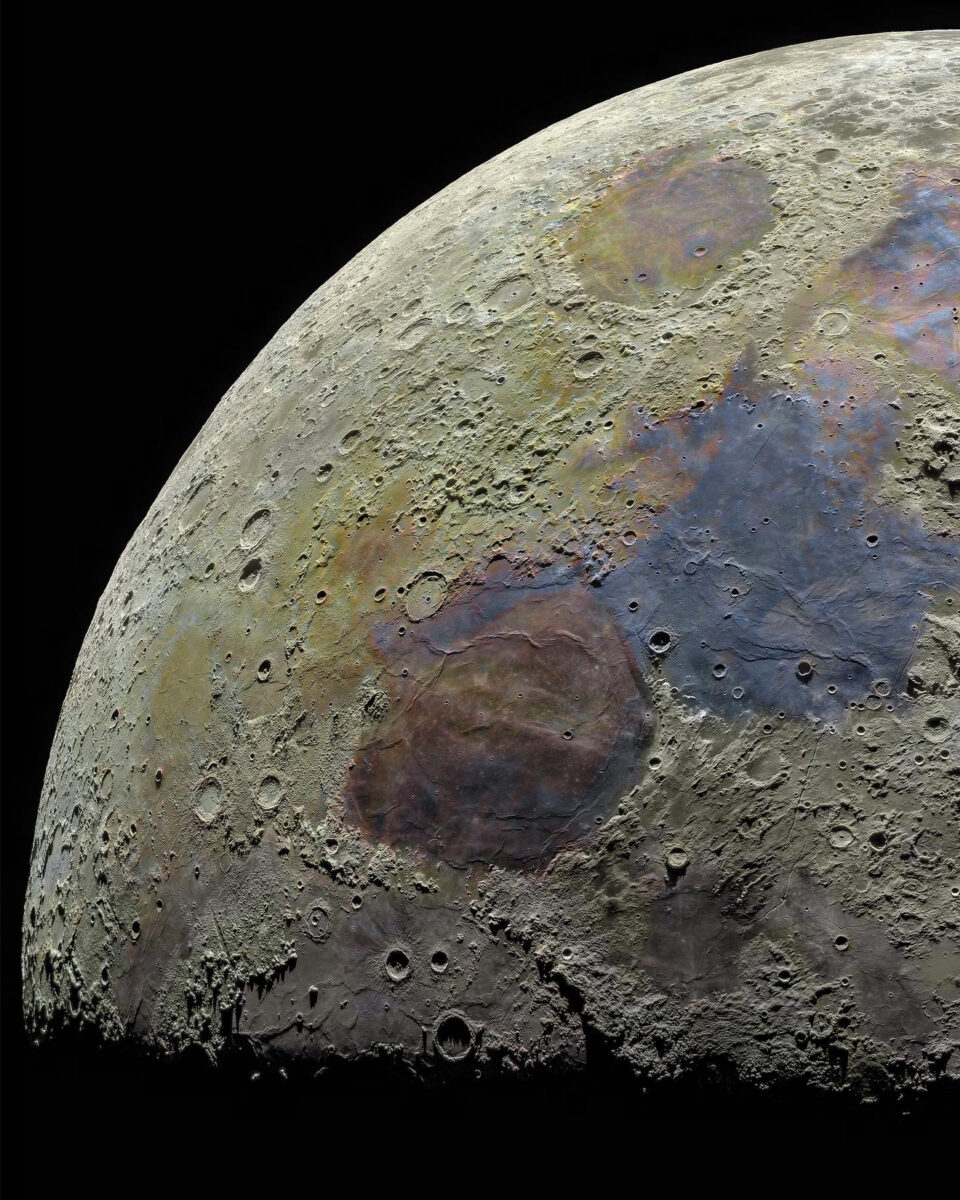
Darya Kawa Mirza is a self-taught Kurdish astrophotographer who produced absolutely stunning images of the moon — by stitching together tons of little ones.
He snapped 81,000 zoomed-in pictures of individual craters, then painstakingly assembled those close-ups into huge composite vistas of the entire moon. The results capture detail that no single photo ever could, as Grace Ebert writes in Colossal …
For this composite, he wanted to create a mosaic that pieced together images of the moon across four different phases, what he calls “phase fusion.”
“This technique is so hard and so painful because you have encountered the movement of the moon on its axis. You can’t just merge two moon phases easily because (they don’t) align,” he tells Colossal.
Instead, Mirza merges all the images frame by frame, offering a rare glimpse of both the unique celestial landscape and the shifts in light and shadow as the moon’s visibility changes over a few days.
It’s astonishing work. There’s a whole gallery of pix at that Colossal post — go check them out, then go look at Mirza’s Instagram feed, which has tons more.
2) 💬 “Cryptophasia”
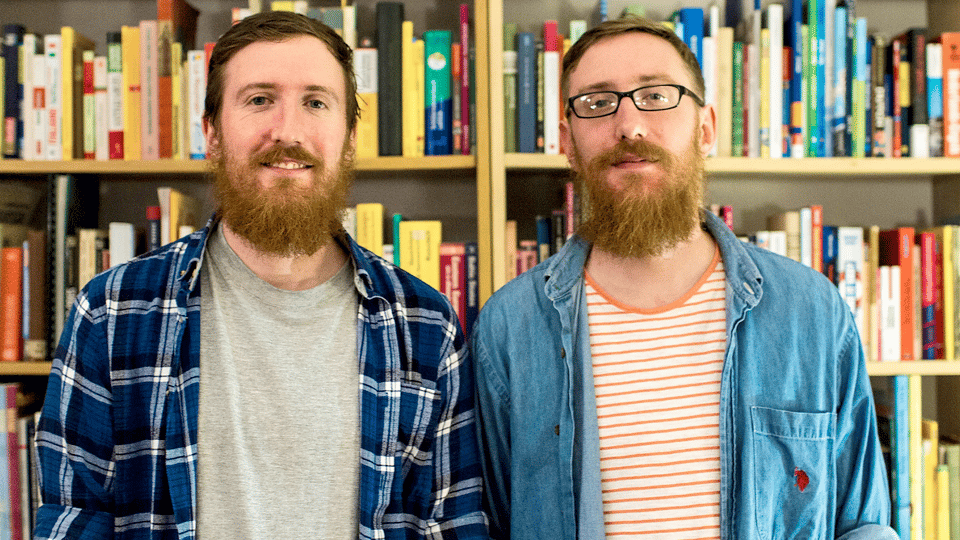
“Cryptophasia” is when twins develop a unique shared language, with its own idiosyncratic vocabulary that no-one else but the twins can understand.
As Krupa Padhy writes on the BBC’s web site …
Twins Matthew and Michael Youlden speak 25 languages each. The 26th is Umeri, which they don't include in their tally.
If you've not heard of Umeri, there's good reason for that. Michael and Matthew are the only two people who speak, read and write it, having created it themselves as children.
The brothers insist Umeri isn't an intentionally secret language.
"Umeri isn't ever reduced to a language used to keep things private," they say in an email. "It definitely has a very sentimental value to us, as it reflects the deep bond we share as identical twins."
Fascinating piece! Apparently about 40% of twins develop a “cryptophasic” language. Scientists suspect it happens partly because twins are together so much, from such a young age — plus they’re sometimes left to play alone for long periods (they entertain each other well). Most drop their cryptophasiac vocabulary as they age, but some don’t: Those Youlden twins kept evolving theirs as they got older, inventing new words for objects like “iPad” as the need arose.
3) 📝 A will written in shorthand from 1813

In 1897, The Strand magazine published an article entitled “Some Peculiar Wills” — or, stories of wills written or delivered in a weird fashion. There’s a will concealed in a puzzle box, a will written in rhyme …
… and the one you see above, which was (as the author claims at the time) the only will ever written in shorthand.
It’s a two-sided document written by Hugh Worthington. The first side gives all his stuff to his daughter Eliza Price. The second half reads …
Most dearly beloved, my Eliza. Very small as this letter is, it contains the copy of my very last will. I have put it with your letters, that it may be sure to fall into your hands. Should accident or any other cause destroy the original, I have taken pains to write this very clearly, that you may read it easily. I do know you will perfect yourself in shorthand for my sake. Tomorrow we go for Worthing, I most likely never to return. I hope to write a few lines to express the best wishes, and prayers, and hopes of thy true, HUGH WORTHINGTON.
Read the rest of the article and learn the stories of the other oddball wills.
4) 🎨 Radium-age art
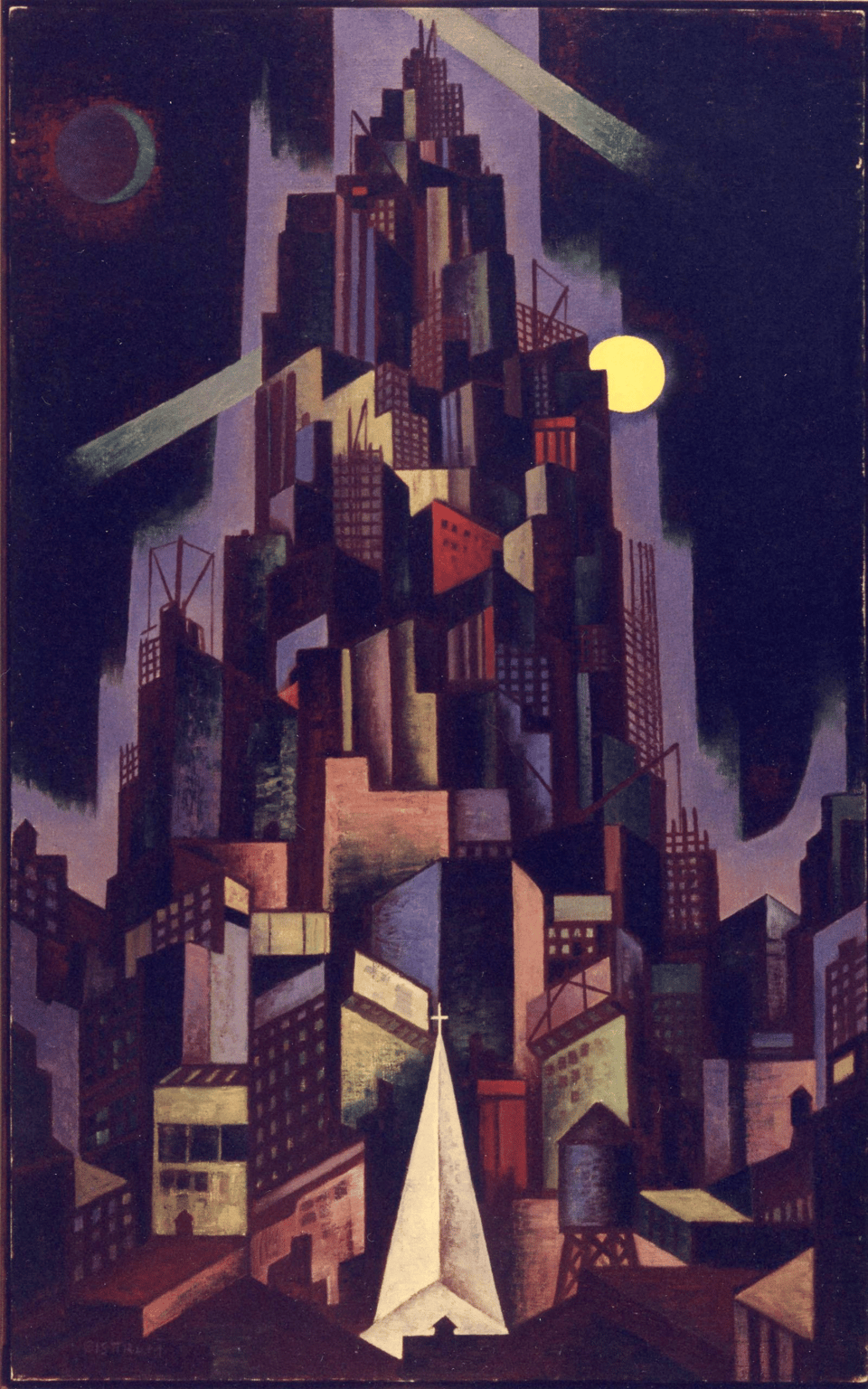
Over at Hilobrow, Josh Glenn has long been doing a series of galleries of “Radium Age Art” — or as he puts it, “proto sf-adjacent artwork created during the sf genre’s emergent Radium Age (1900–1935).”
His latest installment is typically superb. Check out his archives, too.
5) 💨 “The Starry Night” obeys laws of turbulence that weren’t yet discovered
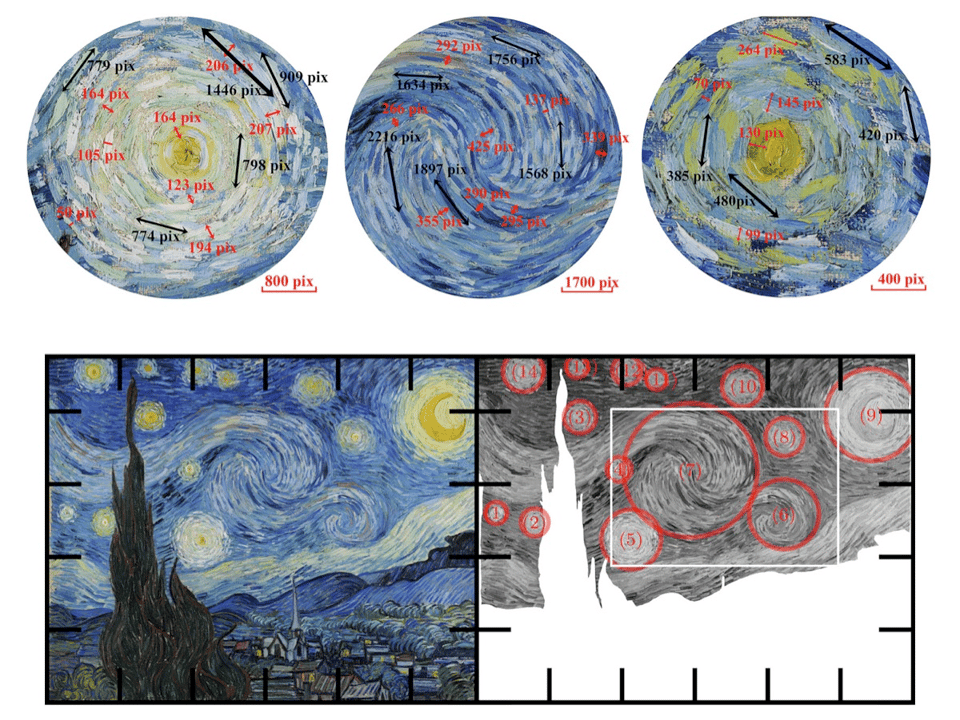
Van Gogh painted “The Starry Night” in 1889, decades before scientists began to outline the laws governing turbulence. But a new analysis of the painting closely measured the gorgeous aerial swirls in that painting — and found they precisely follow the mathematics of turbulence that were devised 50 years later.
Huang and his colleagues precisely measured the brushstrokes and compared the size of the brushstrokes to the mathematical scales expected from turbulence theories. To gauge physical movement, they used the relative brightness or luminance of the varying paint colors.
They discovered that the sizes of the 14 whirls or eddies in “The Starry Night,” and their relative distance and intensity, follow a physical law that governs fluid dynamics known as Kolmogorov’s theory of turbulence.
In the 1940s, Soviet mathematician Andrey Kolmogorov described a mathematical relationship between the fluctuations in a flow’s speed and the rate at which its energy dissipates.
Huang and the team also found that the paint, at the smallest scale, mixes around with some background swirls and whirls in a fashion predicted by turbulence theory, following a statistical pattern known as Batchelor’s scaling. Batchelor’s scaling mathematically represents how small particles, such as drifting algae in the ocean or pieces of dust in the wind, are passively mixed around by turbulent flow.
It’s not like van Gogh was some sort of cryptomathematician, lol, secretly aware of the equations governing turbulent flow, decades before mathematicians began their work. It’s just that — as the scientists in this study note — he was such an attentive student of the natural world that he could replicate the real-life proportions of turbulent waters and gases.
(The paper — “Hidden turbulence in van Gogh’s ‘The Starry Night’” — is here, though alas paywalled.)
6) 👭 Two comb jellies can merge into one
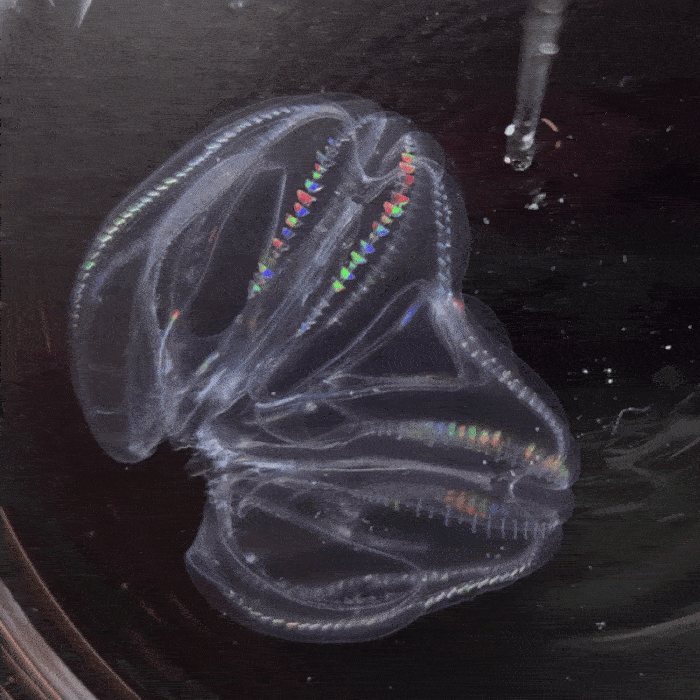
Some marine researchers have made a nutty discovery: When two comb jellies are injured, they can bond together to heal themselves — fusing into one single organism.
The scientists discovered this by accident. They were doing an aquarium inventory of comb jellies — bioluminescent, deep-sea creatures — and when they checked the tank it seemed one was missing. Then they also noticed that one of the other jellies had grown really big. Why was it so huge?
Because, holy cow, it was two fused together!
The scientists realized it was a healing mechanism: If two comb jellies get chunks of their bodies torn off, they repair themselves by merging into one, using each other as spare parts. The Voltron of the briny deep!
To prove it, the scientists experimentally injured some jellies, and sure enough, they fused …
The team then removed a part of the comb jelly’s lobe and placed them close together in groups of two. Nine out of 10 times, the injured individuals became one and went on to survive for at least three weeks.
Additional study revealed that after one night, the two original individuals seamlessly became one without any apparent separation between them. When they poked at one lobe, the whole fused body reacted with a prominent startle response. According to the team, this suggests that their nervous systems also were completely fused together.
Even more …
Their digestive tracts had also fused. The team fed them fluorescently labeled brine shrimp, so that they could follow it throughout digestion. When one mouth ate a brine shrimp, the digestive particles worked their way through a fused canal. The comb jelly eventually expelled the waste products from both anuses. However, they did not poop at the same time.
(That’s all from a good story about it by Laura Baisas in Popular Science. The original study is here.)
So, first off, this is awesome, right?
But it might also be useful. “Allorecognition” is the ability of an organism to differentiate between its body and others — and these processes are tied up in issues of human health, such as whether or not an organ transplant is successful. These creatures don’t seem to possess systems for allorecognition, so studying how and why they don’t could be very illuminating, medically.
7) 📸 “Halide”, a stripped-down camera app for the Iphone

Iphones don’t really take photos any more. When you click the shutter they gather a burst of data about the scene in front of you — then use AI to composite what the software regards as an “ideal” picture. It’s an AI’s view of the world, which is why Iphone photos these days can wind up looking a little too perfect.
So I think I’m gonna try “Halide”, an app that lets you bypass the AI processing — turning the Iphone back into, well, a camera. In the New Yorker, Kyle Chayka writes in praise of it …
It mimics the controls of a digital S.L.R., allowing, for instance, the user to manually adjust the focal length. Halide is a complex app that’s suited for experienced photographers (the name comes from a chemical used in photographic film), but it can also be made very simple, because in August it added a new setting called Process Zero. Once the mode is switched on, the camera does as little processing as possible, avoiding artificial-intelligence optimization and any other dramatic editing of the photo. (It still performs basic tasks like correcting the white balance and lens distortion.) The iPhone typically merges many separate images together to create one composite; with Halide, you get a single digital image that preserves the richness and the contrast of what you see in front of you. Shadows survive. Highlights may be blown out, but the camera doesn’t bring out detail that the eye wouldn’t necessarily catch, as the iPhone does, for instance, with clouds in a bright sky. Where Apple’s automatic editing irreversibly smooths out the digital grain that you get in dim images, Halide preserves it, yielding images that appear more textured. Eschewing the uncanny perfection that marks so much iPhone photography, Process Zero has made me enjoy taking photos with my phone again, because I don’t feel like I’m constantly fighting against algorithmic editing that I can’t control or predict. Ben Sandofsky, the co-creator of Halide, told me, of the program’s ethos, “We’re going to keep this as dumb as possible.”
The makers of Halide have a fascinating write-up of their latest version, including some intriguingly gnarly details about how they worked with Apple so that when you hit “shoot” it’s actually capturing the photons that hit your sensor at that very instant.
8) 🚮 Museum employee accidentally throws art in the trash
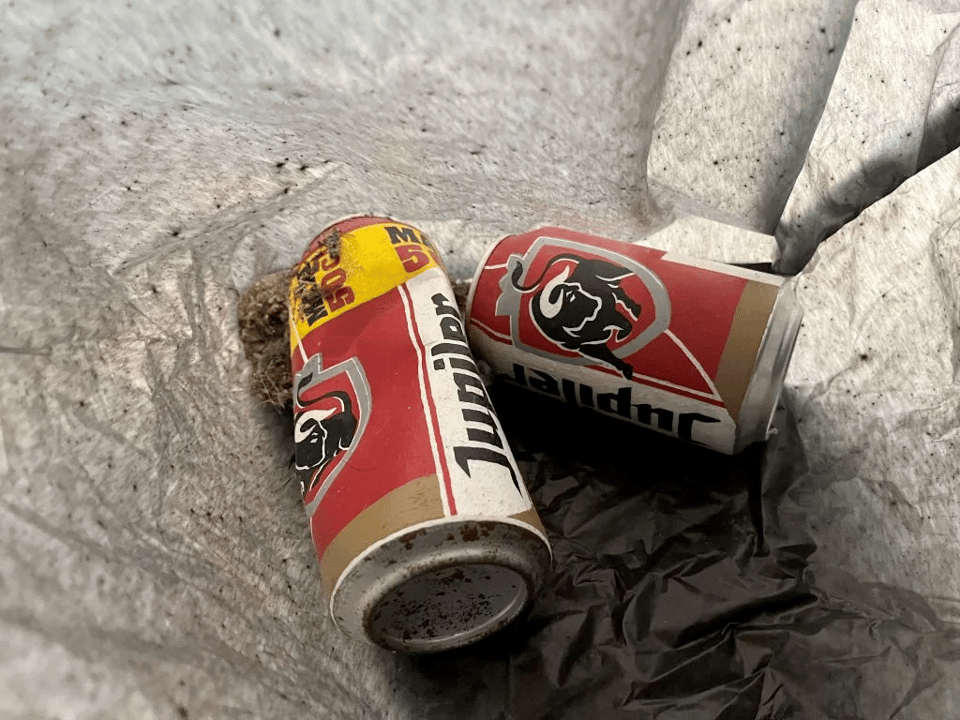
When the LAM Museum decided to do a show based on “food art”, the artist Alexandre Lavet submitted a cool piece — two hand-painted, slightly-crushed beer cans. The curator put them on exhibit in an elevator shaft, to make them look authentic.
Maybe too authentic. An electrical technician chucked them in the trash.
Fortunately, the museum was able to find the artwork in the rubbish bin before anyone took the trash out, and the mistake was quickly rectified. Thankfully, there was no damage to the piece.
Curator Elisah van den Bergh fished the sculpture out of the trash, cleaned it off, and put the cans back on display—this time on a more formal plinth at the entrance to the galleries.
9) 🎸 China’s hit farmer-rock band

Varihnaz is a Chinese rock band that’s blowing up right now — and is composed of a bricklayer and two farmers, who write songs about farm life and have to organize their tours to avoid the fall harvest season.
When they were on “The Big Band”, a Chinese reality TV competition (above, Youtube), they were asked what will you do if you advance to the final rounds in September? “We’ll try not to get to September,” they replied.
Vivian Wang has a great story about them in the New York Times (gift link), which talks about their biggest hit …
“Big Dream,” a song written by Shi Ba, cemented Varihnaz’s popularity on “The Big Band.” The lyrics span a migrant worker’s life, from childhood to old age, and narrate his exhaustion trying to make a living.
Many audience members cried during the taping. The song went viral, with some declaring it an anthem for a disillusioned generation.
It’s rock, but blends in everything from traditional instruments to the sounds of farm tools …
On the first night of the tour, at a sold-out venue in the city of Guilin, Varihnaz shifted between slow songs led by a hand-carved flute, and “Field Song,” a pulsing number in which Lu Min struck the tip of a hoe with a drumstick as Ba Nong curled over an electric guitar.
When they sang in Zhuang, Mandarin translations were projected behind them. One song, “Extermination Curse,” was composed entirely of names of pesticides, recited in a monastery-like chant.
Halfway through the performance, Ba Nong clicked through a slide show, teaching the audience of around 450 people about natural farming techniques. He and Shi Ba had brought bags of their rice for purchase.
Very cool story, check the whole thing out!
10) 🌊 Giving land back to the sea

As the seas rise under global warming, coastal areas are seeing increased flooding — with more to come.
What to do? One new approach that’s gaining traction is to stop trying to resist the incoming sea. Don’t build walls; instead, dig canals and routes so that when there’s a surge of ocean water, it has a place to go inside the land — and also a route to retreat when the swell is over.
In the New York Times (gift link), Rory Smith describes one such fascinating experiment in Somerset, UK. The region had been suffering from so much rain and seaswell that entire villages had been cut off. So a local environmental group, working with the government, bought up land to build canals that would let the sea come in.
It worked remarkably well. Not only has the flooding stopped, but the seawater has created a “salt marsh”, a complex biosystem that has rejuvenated the area’s wildlife …
The marsh acts as a natural and hugely effective bulwark against flooding, absorbing and slowing tides before they can encroach inland. Even last winter — the wettest anyone in the area could remember — the village at one edge of the peninsula did not flood. Paths through the marsh remained passable. A steep bank, covered with grass and significantly higher than the old flood wall, now borders the river.
The area is also a haven for wildlife. Bird-watching blinds with giant windows offer glimpses of godwits, plovers, oystercatchers, egrets and herons. A growing population of avocets — black-and-white wading birds with distinctive, curling beaks — has gathered around the pools of brackish water.
Before the project began, some residents were so hotly opposed that they called it “environmental vandalism”. Now that they see the benefits, locals are lining up to do volunteer shifts helping to maintain the salt marsh’s native plants. Also, the local dairy cows love the grasses that grow in the new terrain.
Oh, and, bonus: This is essentially re-setting the land to its original state. Before industrialization, these coastal areas of the UK used to be natural salt marshes; over centuries, they were drained to produce farmland. Fully 85% of the UK’s former salt marshes are gone.
So this experiment isn’t so much tinkering with the land as un-tinkering with it, helping to make it — as it was historically — sustainable and resilient.
11) 🟡 Yellow is the color of silence in heaven
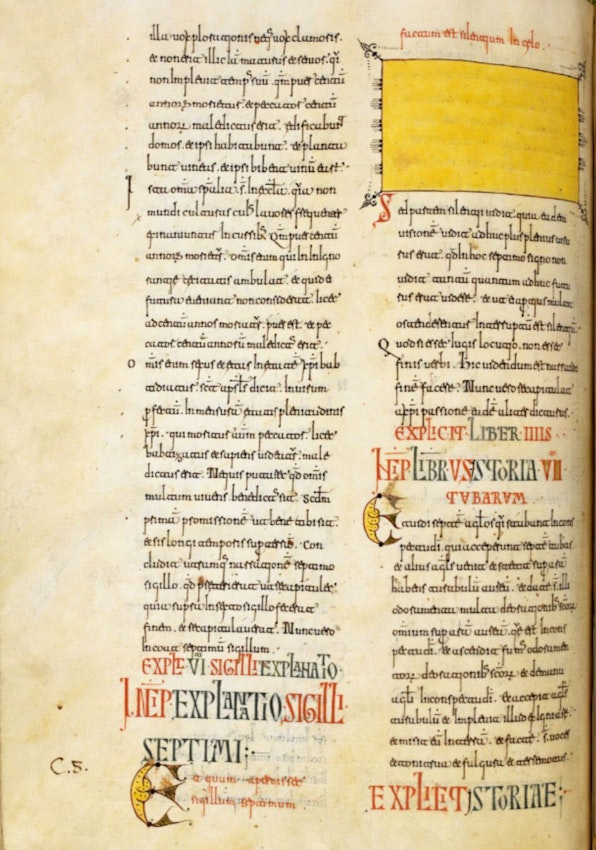
In the Biblical book Revelation, after the seventh seal is opened, heaven falls silent for half an hour. (Revelation 8:1 to be precise.)
For centuries, creators of illustrated-manuscript Bibles weren’t quite sure how to depict this curious period of silence. Revelation is full of Michael-Bay-style action — multiheaded beasts rising from the ocean etc. — so illustrators loved that stuff. But when it comes to the silence? They mostly just avoided it.
Until this manuscript you see above! As the Public Domain Review notes …
This is not the case for a miniature from the twelfth-century Silos Apocalypse (British Library Add MS 11695, fol. 125v), a codex copy of the Tractatus de Apocalipsin, eighth-century Spanish theologian Beatus of Liébana’s commentary on the Book of Revelation. Here sonic absence is visualized, and it is yellow. Just as silence blankets the ears, in this manuscript, a monochromatic rectangle “serves as an effective screen that blocks the beholder’s gaze”, writes art historian Elina Gertsman. Auditory interruption gets transposed onto the textual plane, as the rectangle veils the ruled lines it floats above. “It’s not that yellow as a color ‘stands for’ silence according to medieval symbolic logic”, argues scholar Vincent Debiais, “it’s that the colored area on the page opens a visual moment, a space of silence within the manuscript itself.” The effect becomes all the more palpable when we consider that the manuscript may have been read aloud.
12) 🌞 Solar may be growing even faster than we think

Solar power is modular — you can buy a portable, handheld solar panel to charge your phone, or you can build a 30-acre solar farm to charge a town. In a lot of places worldwide you don’t even need to alert your local government that you’re putting panels on your roof. You just do it.
And that means governments worldwide don’t actually know how much solar is out there. So as Zoë Schlanger argues, solar may be growing much faster than officials estimate.
Globally, some 40 percent of solar’s growth is in the form of people powering their own homes and businesses, Bahar said. Perhaps nowhere is this better illustrated than in Africa, where Joel Nana, a project manager at Sustainable Energy Africa in Cape Town, has been leading an effort to help countries regulate and integrate the explosion of small-scale solar. When Nana and his team started quantifying just how much new solar was around, “we were actually shocked,” he told me. In South Africa, for example, the total amount of energy produced from solar systems in 2019 was thought to be about 500 megawatts, Nana said. But in the first quarter of 2023, when researchers used satellite imagery to count all of the solar installations in the country, they estimated that solar was producing a combined 5,700 megawatts of energy—only 55 percent of which had been declared to the government. That story of rapid, invisible growth is being repeated across the continent. Kenya now has about 200 megawatts of rooftop solar installed, representing 9 percent of the country’s total energy use, Nana said. Namibia has about 96 megawatts of rooftop solar capacity in its system, he said—a whopping 15 percent of its energy mix. “It’s been happening for three or four years, maybe five years, completely off the radar,” Nana said.
Fascinating piece; unpaywalled link here.
13) 🗿 Did Easter Island inhabitants invent the newest language ever?
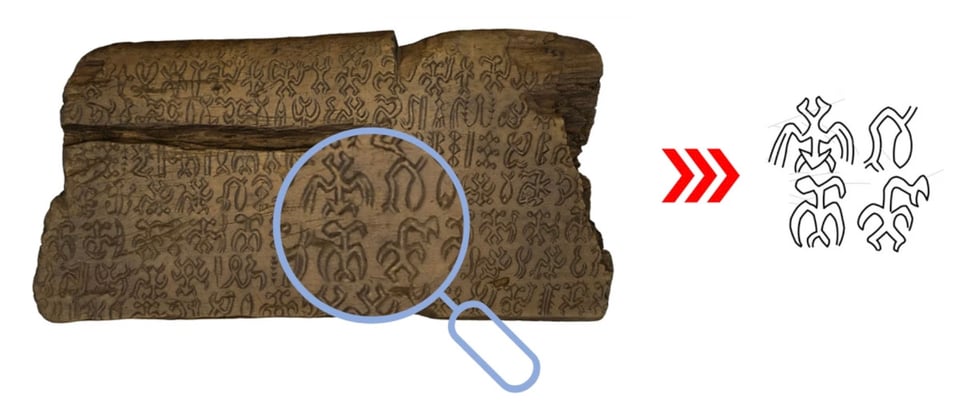
The emergence of new forms of written language are historically pretty rare. I’m talking about a society inventing writing all on its own, as an original creation, without ever being exposed to writing from another society. The few well-agreed-upon examples emerged in Mesopotamia, Egypt, China and Mesoamerica, and they all happened thousands of years ago.
There’s a fascinating newer candidate, though: The Rapa Nui of Easter Island.
They first arrived on the island — one of the world’s most geographically isolated locations — sometime between 1150 and 1280. Nobody from the outside (that we’re aware of) visited them until Jacob Roggeveen, a Dutch navigator, in 1722. So 1722 is the first moment of outside contact.
Early European visitors noticed that the Rapa Nui had a cool 3D script, called “Rongorongo”, that they carved onto wood. But the ability to read Rongorongo was quickly destroyed by European contact, as new diseases and slave raids decimated the population. It wasn’t long before nobody was left who could read the local language. These days it’s undecipherable, and no Rapa Nui have any passed-down knowledge about its history or development.
So: Was the language influenced by Europeans? Or did the Rapa Nui invent it before Europeans came along? If so, it’d be the most modern one we’re aware of!
To figure this out, some scientists recently did radiocarbon dating of wood from some of the very few existing samples of Rongorongo.
The results? Rongorongo may indeed be older than contact. As the scientists conclude …
… the glyphs differ from any known script and, even in terms of inventory, they have no close parallels. If Tablet D's exceptional age indicates that the local population of Rapa Nui could have invented a writing system without influence or input from external agents, Rongorongo could represent one of the few independent inventions of writing in human history, adding a layer of complexity to the narrative of the cultural and historical development of the Rapa Nui inhabitants.
You can read their whole unpaywalled paper here; it’s very layperson-accessible and damn interesting. Darren Orf also wrote about it for Popular Mechanics.
More research will be needed here, but it if continues to check out, it’s a remarkable story.
14) 🚸 A final, sudden-death round of reading material
“Video scraping.” 🚸 Participatory drum machine. 🚸 Playing Doom in the iOS Photos app. 🚸 Oh, and on a Redbox too! 🚸The most terrifying film scores of all time. 🚸 41-million-digit prime found. 🚸 The nerd license plates of MIT. 🚸 No one knows how big pumpkins can get. 🚸 The Poetry Pharmacy. 🚸 Play Frogger: Walkable City. 🚸 “Kishōtenketsu”. 🚸 This “Moonshine” voice-to-text software looks promising. 🚸 San Francisco public transit finally stops using 5.25-inch floppy disks. 🚸 AI model helps uncover new Nazca lines in Peru. 🚸 Mechanical logic gates with amplifiers, using string and levers. 🚸 The first museum devoted to BBQ. 🚸 How melting oceans would add 2 milliseconds to the length of the day. 🚸 DIY chicken coop with predator detection. 🚸 They made Wigner crystals, composed solely of electrons. 🚸 Creepy little spider using WebGL. 🚸 Geothermal power from volcanos. 🚸 The blind breast-cancer detectors of India. 🚸 A theoretical proof, based on informational entropy, that we live in a simulation. 🚸 The wheel may have been invented 6,000 years ago by copper miners. 🚸 20 useful VSCode extensions. 🚸 Robot hand that listens with its fingers. 🚸 The carbon-sequestering promise of “midwood”. 🚸 Sneakers that expand as your feet grow. 🚸 That’s why it’s called a “monkey wrench”. 🚸 Ant-fungi collaboration. 🚸 George Harrison writes a note explaining why you should play ukulele. 🚸 Manual of seven old programming languages. 🚸 New Brachycephalus just dropped. 🚸 The math behind running through the rain. 🚸 “Waymap”, like Google Maps but for the blind. 🚸 Which secret billionaire died and paid $7 billion in taxes? 🚸 Color eink cases for phones. 🚸 The world’s smallest Rubik’s Cube. 🚸 They’re still making Homebrew video games for the 1976 Fairchild System F console. 🚸 A wall clock that dislays your ping rate. 🚸 New homes don’t have hallways. 🚸 A (3+3+3+3)+3-Axis Tourbillon. 🚸 Real-life Spider-Man web-slinging tech. 🚸 Hidden patterns in folk songs. 🚸 Mobius keyboard.
CODA ON SOURCING: I read a ton of blogs and sites every week to find this material. A few I relied on this week include Andrew Drucker’s Interesting Links, The Overspill, Hackaday, Futility Closet, and Mathew Ingram’s “When The Going Get Weird”; check ‘em out!